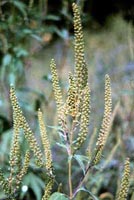Resource Library
Plant of the Week: Ragweed, Common
The University of Arkansas System Division of Agriculture does not promote, support or recommend plants featured in "Plant of the Week." Please consult your local Extension office for plants suitable for your region.
Plant of the Week
Common Ragweed
Latin: Ambrosia artemissifolia

It’s ragweed season so sniffling and sneezing have become my daily companions. Were
I alone in my suffering my discontent would be heard far and wide. But all of us allergy
sufferers endure the floristic injustice in silence while we await either a good rain
to wash the air or that first killing frost. For most of us the main culprit this
time of year is common ragweed. This weed is a problem throughout the entire country
but most concentrated in the eastern half of the United States.
Ragweed is a member of the daisy family, but unlike most members of the group, it
lacks the showy strap-shaped ray petals that give the daisy its characteristic appearance.
Three ragweed species are encountered in the eastern states but A. artemissifolia is the most common in Arkansas. It is an annual weed that grows in pastures, roadsides
and about anyplace except in the shade of trees. Plants reach 12 to 16 inches tall
with dissected greenish-pubescent leaves up the erect stems.
The insignificant appearing flowers are produced at the ends of the branches in 6
inch long spikes with the flowers in clusters up the spike. Flowers at the base of
the spike are usually female and produce next years seeds while those towards the
ends are the male flowers that produce all of the pollen. Ragweed is a plant with
wind borne pollen with flowers appearing from July through October. Its pollen is
small enough - between 20 to 50 microns in size - to float long distances without
settling to the earth. Pictured here is giant ragweed, A. trifida which is an introduced weed that can grow six to eight feet tall.
Some people seem highly sensitive to allergens and are bothered by a wide variety
of plant pollens while others are specialists and only respond to one or a few kinds
of pollen. On the first exposure a sensitive individual’s immune system reacts to
the proteins in the pollen and produces antibodies specific to those proteins. The
next time the pollen grains are inhaled and embed themselves in the mucous of the
nasal lining, the immunoglobulin antibodies of the immune system recognize the foreign
protein and produce chemicals such as histamines in response to the insult to the
immune system. These histamines cause dilation of capillaries, contraction of the
nasal muscles and an excess secretion of nasal fluids. Walla - all of the symptoms
of a hay fever attack.
Many fall blooming plants - but especially goldenrod - are incorrectly blamed for
causing allergies. Goldenrod has the misfortune of blooming at the same time as the
ragweed. Because ragweed flowers are not at all showy, they are often overlooked as
people scan the roadsides for the cause of their discomfort. Goldenrod is largely
insect pollinated. The pollen grains are too heavy for wind transport and must be
moved by bees or other insects as they work the flowers.
By: Gerald Klingaman, retired
Extension Horticulturist - Ornamentals
Extension News - August 27, 1999
The University of Arkansas System Division of Agriculture does not maintain lists of retail outlets where these plants can be purchased. Please check your local nursery or other retail outlets to ask about the availability of these plants for your growing area.